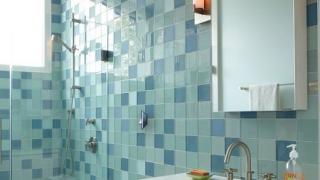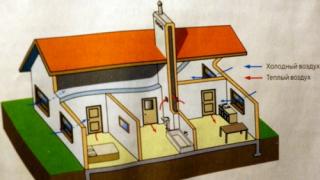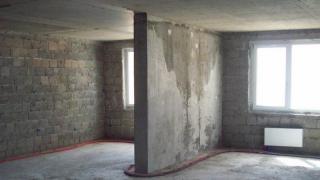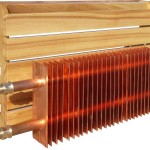
Hello dear Reader!
I want to tell you about what heating systems I had to deal with.
Some he exploited, some he assembled himself, including heating systems for private houses.
I learned a lot about their pros and cons, although, probably, not everything. As a result, for my house I did:
- first, own scheme;
- secondly, it is quite reliable;
- thirdly, allowing modernization.
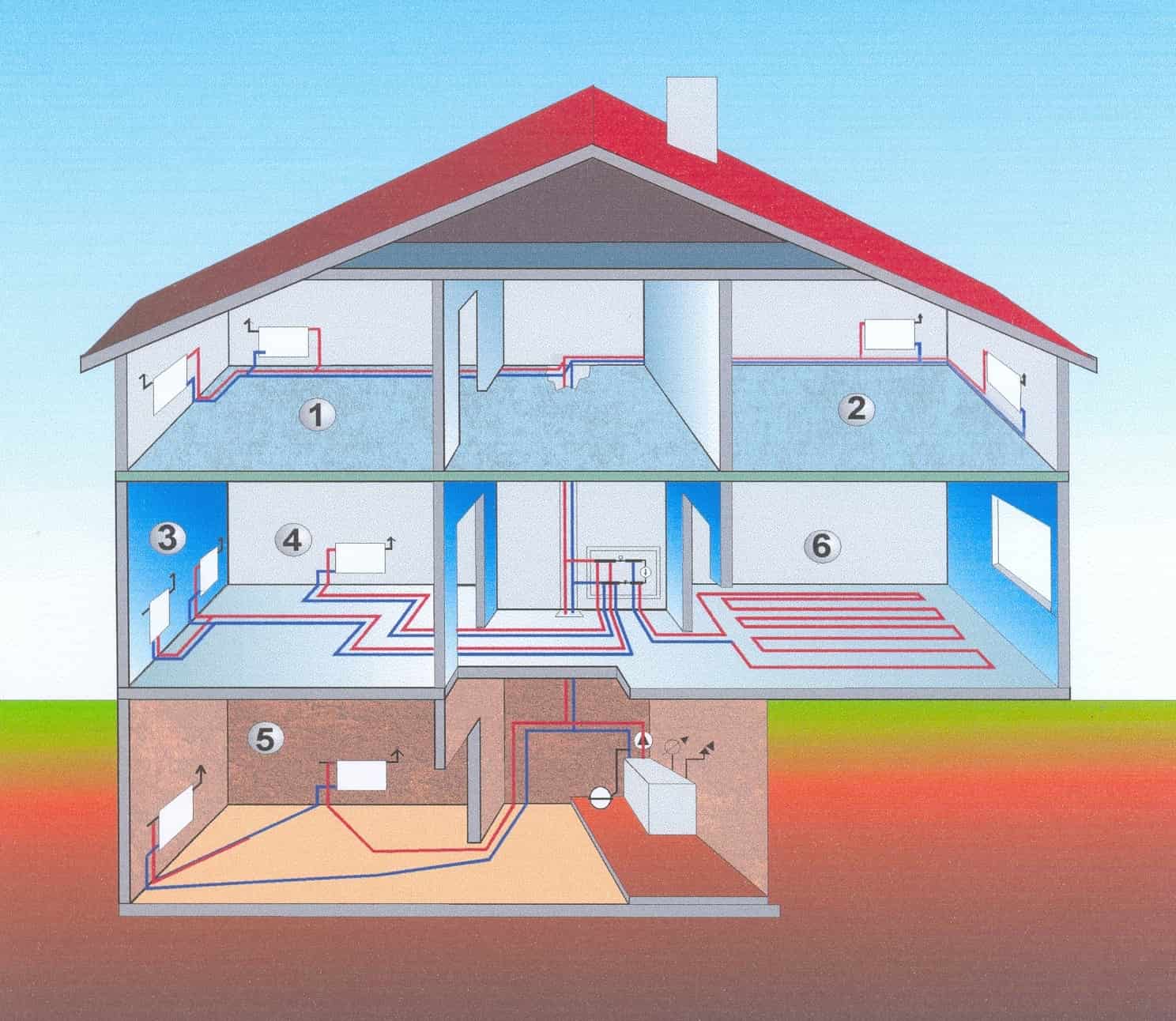
I suggest not to delve into a detailed study of various heating schemes.
Let's look at them from the point of view of application in a private house.
After all, a private house can be for permanent residence, and temporary, like a dacha, for example.
So to speak, let's narrow our topic and get closer to practice.
About ten years, maybe I was wrong. I started servicing the first heating system 33 years ago, when I was a student at the Ural Polytechnic Institute. I was lucky to get a job in the institute's boiler room as a mechanic on duty. True, at that time I didn’t even think about what kind of system it was? Worked and everything.
The work was sometimes difficult when there was an accident. And if everything is fine - beauty, sit yourself and learn notes. Night on duty, in the morning to study, "to school", as we then said. Back on duty two nights later. And most importantly, they paid 110 - 120 rubles! At that time, young professionals received the same amount. Yes, plus a scholarship of 40 rubles. Gorgeous life! But, let's get closer to the heat.
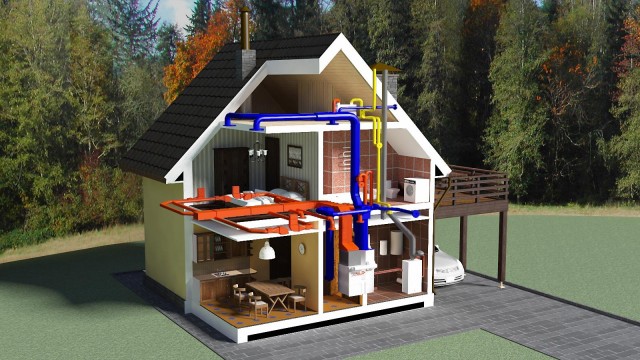
From the name itself it is clear that heating occurs with heated air. The air is heated by a heat generator, and then it enters the premises through ducts. The cooled air is returned to the heating system through the return channels. Pretty comfortable system.
The first heat generator in history was a furnace. She heated the air, which diverged through the channels in the order of natural circulation. Such an air heating system was used in the past centuries in advanced city houses.
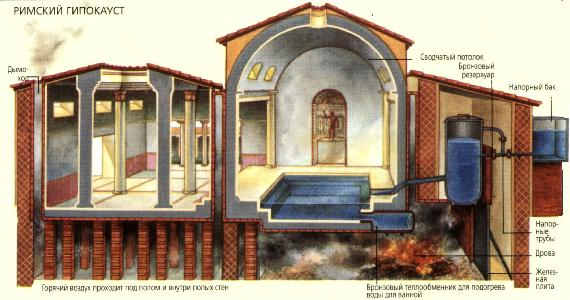
Now they use a variety of heat generators-boilers: gas, solid fuel, diesel, electric. In addition to natural circulation, forced circulation is also used. It is, of course, more efficient:
- Firstly, it warms up the premises much faster;
- Secondly, it has a higher efficiency, since heat is removed from the heat generator much more efficiently;
- Thirdly, it can be combined with the air conditioning system.
You probably already understood that here it doesn’t “smell” like a private house. Yes, that's right, for a private house this heating scheme is too cumbersome and expensive. Some calculations are worth something, and if you make a mistake, then it will be, as they say, fatal.
But let's not get upset. If you still want to be heated by air, there is a way out. This is a fireplace.
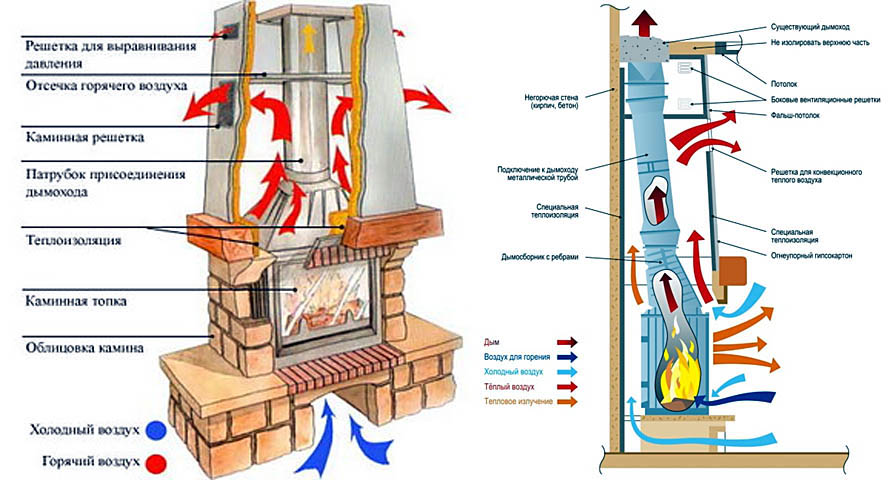
Moreover, in my opinion, not an ordinary firewood-eater fireplace, but a cast-iron fireplace insert shown in the figure above. This is an ideal option for a homely cozy wood-burning heat generator. It is designed specifically for heating air, and not bricks, like a traditional fireplace.
The air enters the space under the fireplace (where the firewood lies for the entourage), flows around its heated body. Then it flows around the red-hot chimney along the fireplace box and exits through the holes in the upper part of the box. By the way, air ducts can be connected to these holes and hot air can be distributed throughout the premises.
Quite a worthy option, only if done with air ducts, then during construction you need to remember to put them in walls and ceilings. Someone also puts a blower, creating forced ventilation. But this, in my opinion, is overkill. By the fireplace, it is nice to hear the crackling of firewood, rather than the noise of a fan.
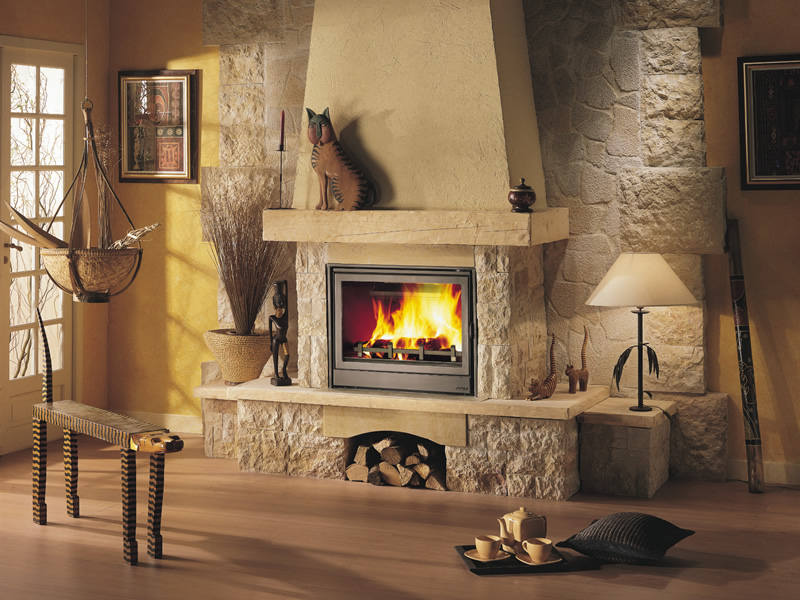
I think it is worth mentioning more fan heaters and heat guns. These are, so to speak, mobile air heating units. Very useful devices, especially when the main heating system is not working or you need to quickly “warm up” the air in the room. But, in my opinion, they cannot be considered as the main heating option.
So, a fireplace insert, as a source of air heating, is a good, and, moreover, a pleasant solution for a private house.
Water heating at home
In this case, the coolant is water or special liquids, for example, non-freezing. Here, the heat sources are also very different depending on the fuel. But if there is warm air in the air system comes into the room, then into the water air of the room heated by appliances who give him heat stored in water.
![]()
And the water stores a lot of heat. There is such a thing: "heat capacity", remember? If in your own words
The heat capacity of water is the amount of heat that must be transferred to water in order for its temperature to rise by one degree.
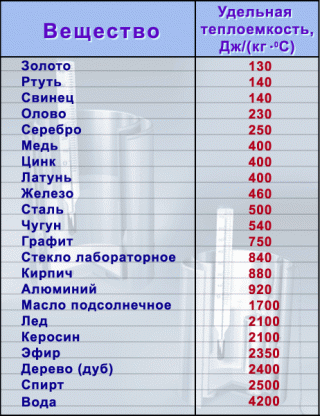 So this indicator near the water is very good. Look at the table on the right.
So this indicator near the water is very good. Look at the table on the right.
It turns out that we get a chic coolant almost for nothing.
Yes, the water system is somewhat more complicated, but it is also more flexible.
Imagine that heated water can be supplied through pipes anywhere and there it will give off the accumulated heat.
And the pipes can be easily hidden in the walls, or you can not hide them at all, modern ones look very aesthetically pleasing.
How does water give off heat? For this, several types of devices have been created:
- Radiators - massive, for example cast iron, sections assembled into batteries.
Hot water flows inside them. They give off thermal energy mainly due to infrared radiation (radiation).
They are usually steel or aluminum, less often copper. The surrounding air, being heated by the convector, begins its natural upward movement. That is, a flow (convection) of air is created, which removes heat from the convector.
Modern aluminum appliances also belong to convectors, although they are called radiators. It should be noted that now almost all thermal devices for water heating are called radiators, although strictly speaking, this is wrong. But let's not be smart.
Air is pumped through them to be heated. They are often used in supply ventilation systems to heat cold air entering from outside.
- "Warm walls" - were used in the seventies in panel housing construction. A serpentine from a steel pipe was embedded in the concrete panels, into which water was supplied from the heating system. I remember from childhood the warm walls of panel five-story buildings.
The water system can be successfully used in a private house. If this is a dacha, you can fill in a non-freezing coolant instead of water and not worry about defrosting the system.
Let's take a closer look at the options for heating systems for low-rise buildings.
Scheme of a gravity heating system
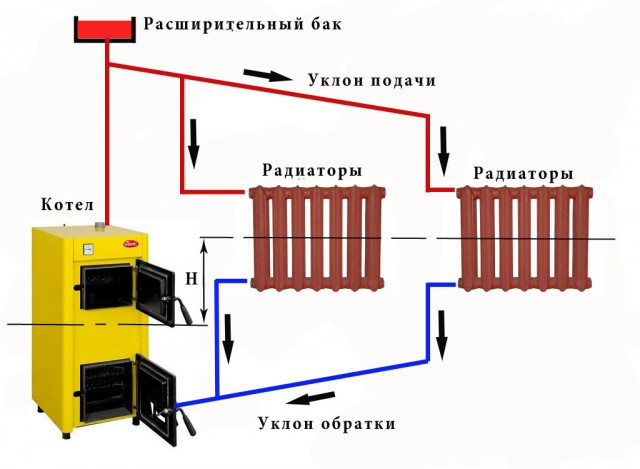
Why self-flowing? Because the water in it actually flows by itself. When heated in the boiler, the water rises, and then, gradually cooling in the radiators, flows down and returns to the boiler again. The system is simple, but the prerequisites must be observed:
- The pipe should be of a fairly large diameter from 50 mm, and preferably 76 mm or more.
- The pipe is laid with a slope to ensure the gravity flow of water.
Sometimes this same pipe heats the room without radiators and convectors due to its large mass and surface. Such pipes are called registers, they can be found at railway stations and bus stations of old small towns. It is now rarely used in private homes - it does not look very aesthetically pleasing. Imagine - there is a thick pipe in the room, and even an inclined one.
A very big advantage of this system is that it does not need a circulation pump, the water circulates itself. If the boiler is wood, coal or gas - no power outages are terrible, complete autonomy and independence. I'm talking about this because I myself have trouble with power outages.
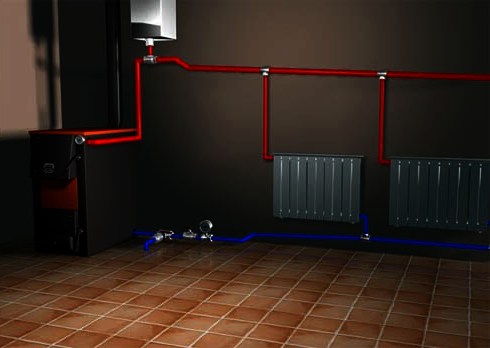
A feature of a gravity-flow system, which is considered a disadvantage, is that it is open, that is, it communicates with air and there is no pressure in it. This means that an open expansion tank is needed and the water gradually evaporates, you need to monitor this. Of course, this is not a very serious drawback. I'm more repulsed by high sloping pipes.
For a private house, a closed heating system, in my opinion, is the best option. It's better to say closed. Closed means not in contact with air. Here are the new elements:
- Membrane expansion tank to compensate for the expansion of water when heated;
- Circulation pump for pumping water through the system;
- Safety group - make-up valve (for adding water to the system in case of leakage), pressure gauge, safety valve (for releasing steam when water boils).
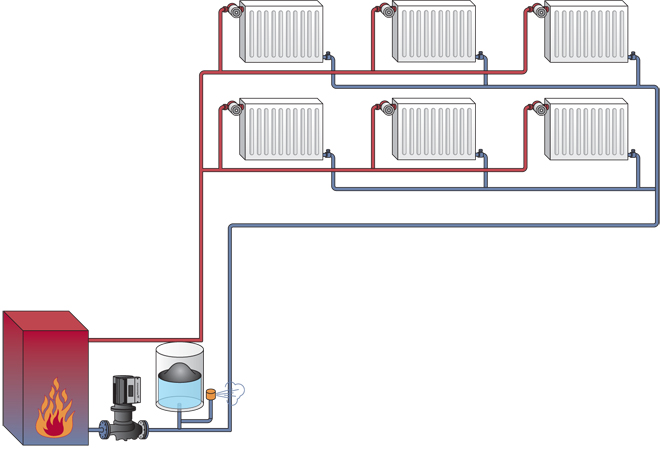
This is a more modern, aesthetic option. Radiators are used here, and more often aluminum convectors, thin metal-plastic or polypropylene pipes. There is no need to add water, think about the slope of the pipes, they can generally be hidden in walls or ceilings.
You can put beautiful aluminum or bimetallic radiators, a heated towel rail. I use two boilers in one system - an electric boiler and a water circuit for a fireplace insert. Like it worked out well.
The minus of the system is that it cannot work without electricity for the circulation pump. Moreover, if the firebox is “under steam” and the electricity is over, it can turn out to be a “boomsik” with the release of steam and a lot of noise. I know for myself. It looks like the pipes are being pounded with a hammer.
Therefore, the pump was connected to an uninterruptible source (like a computer) so that there was time to safely cool the firebox. And the outlet of the safety valve is in the sewer.
Two-pipe heating system
There are two options for connecting radiators to the heating system:
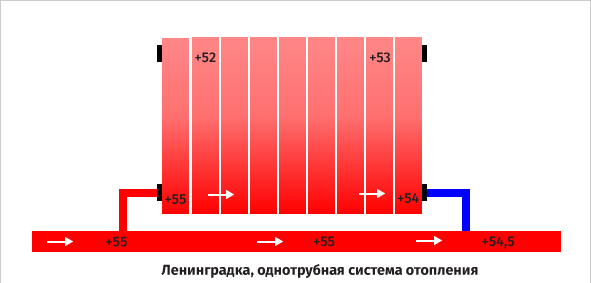
The only plus of a single-pipe system is savings on pipes. But the minus is significant - the radiator closest to the boiler is the hottest, and the farthest is the coldest. And it’s also problematic to turn off some kind of radiator - they are all in the same circuit. If this is not critical, why not use this option? It's a perfectly normal pattern.
The two-pipe scheme is more flexible:
- All radiators are almost equal. Water is supplied to each at the same temperature;
- You can set your own temperature on each radiator by regulating the flow of water through it;
- You can painlessly shut off the water supply to any radiator, for example, when it's hot or you need to flush the radiator;
- More convenient for increasing the number of radiators.
Thus, in my opinion, a two-pipe scheme is more preferable.
For the sake of justice, it must be said that in the two-pipe version, the last radiator is somewhat “offended”, it gets less heat. The reason is that on it the pressure difference between supply and return is almost zero and the water flow is minimal.
So what choice did I make?
I installed an air-to-water heating system in my house. The fireplace is responsible for the air. The closed two-pipe water circuit includes an electric boiler, a fireplace insert water circuit and 40 aluminum radiator sections (6 radiators). 64 square meters of the first floor are heated in excess in any frost.
That's all for today. In the following articles I will bring to your attention a gas heating system, underfloor heating, infrared heating. Comment, ask questions. Thanks, see you!

